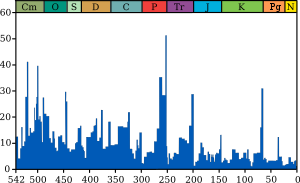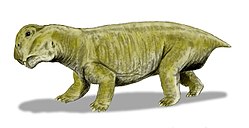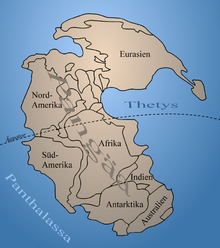Permian Triassic border

This occurred at the Permian-Triassic boundary (also called the PT boundary or Permian-Triassic event ) around 252 million years ago, at the transition from the Permian to the Triassic , at the same time the boundary between the Paleozoic (Earth Age) and Mesozoic (Earth Middle Ages) largest of the five mass extinctions during the 541 million year Phanerozoic .
This affected around 75 percent of the terrestrial fauna, including many insect species, as well as a large part of the vegetation cover. The effects in the oceans were even more dramatic: around 95 percent of marine invertebrates died out there, including large foraminifera , paleozoic corals , trilobites and Eurypterids . Bryozoa , brachiopods , crinoids and ammonoids were severely decimated . Mollusks were less affected by the extensive extinction of species.
The main factor for the collapse of almost all ecosystems is generally considered to be the large-scale flood basalt emissions of the Siberian Trapps , whose activity cycles covered an area of 7 million square kilometers with igneous rocks over several hundred thousand years and which caused a series of serious consequential damage.
The mass extinction
Geographical and temporal classification
In the Permian there was a single large landmass, the supercontinent Pangea , created by the merger of the two major continents Laurussia and Gondwana in the Upper Carboniferous about 310 million years ago. Driven by plate tectonic processes, the disintegration of the supercontinent began from the late Triassic (around 230 mya) and was initially limited to the southern regions. At the height of its expansion, Pangea stretched from the northern polar region to the Antarctic and had an area of 138 million km² including the shelf seas . Large continents and supercontinents are characterized by a pronounced continental climate with an annual temperature amplitude of up to 50 Kelvin, large arid and desert areas in the interior of the country and a low level of biodiversity in the fauna area . In addition, a seasonally occurring, very strong monsoon influence (“mega-monsoon”) developed parallel to the equator between latitude 30 ° north and 30 ° south , from whose precipitation the coastal regions in particular benefited.
The older scientific literature estimated the duration of the mass extinction at the Permian Triassic border to be at least 200,000 years. According to an analysis published in 2014, this time window is reduced to two core areas of 60,000 years each (± 48,000 years). In contrast, a study published in 2018 came to the conclusion that the immediate crisis period only spanned a maximum of 30,000 years, possibly limited to a few millennia. The global collapse of ecosystems could be dated to the lowest Triassic 251.94 million years ago with the help of new measurement methods with low error tolerances.
Megavolcanism
The flood basalt activities of the Siberian Trapps were the most momentous volcanic event in known geological history in terms of their impact on the biosphere . This Magmatic Greater Province encompassed large parts of today's West and North Siberian Lowlands and the Central Siberian Mountains over an area of no more than 7 million square kilometers and layered igneous rocks with a thickness of 3,500 meters in places. Over a period of several hundred thousand years, megavolcanism emitted considerable amounts of carbon dioxide , fluorine , hydrogen chloride and sulfur dioxide , which as sulfuric acid in rainwater damaged oceanic and continental biotopes in equal measure. With regard to pollutant emissions, the flood basalts were probably reinforced by extensive coal fires in connection with global fly ash deposits. Due to the high CO 2 emissions from the trap, the global temperature increased by 5 ° C within a geologically very short period of time. This significant warming led directly to the core phase of mass extinction.
Effects on the climate and the environment

At the beginning of the Permian, the oxygen content of the atmosphere was around 30 percent, while the carbon dioxide concentration fell to what is probably the lowest value in the entire Phanerozoic and barely exceeded 100 ppm during the same period . Towards the end of the epoch, almost 50 million years later, the situation was reversed: While the oxygen level fell to a level of 10 to 15 percent in the course of the worldwide shrinking of vegetation, the CO 2 concentration increased due to the outgassing of the Siberian trap , drastically too. Although different information about the exact volume of greenhouse gas release is circulating in the specialist literature , it is generally assumed that the Permian Triassic boundary recorded a CO 2 equivalent of several thousand ppm.
Paleoclimatological analyzes of the 18 O / 16 O isotopes document a warming of the upper sea layers of at least 8 ° C by the end of the event. With the formation and spread of anoxic zones and the rapid drop in pH , mass extinction began in the oceans. The strong acidification of the seas is considered to be one of the main causes of the extensive disappearance of marine life forms. Another factor was the destabilization of the methane hydrate deposits on the continental shelves , causing large amounts of methane to diffuse into the atmosphere. This additional drive of the greenhouse effect led to a global temperature jump of another 5 ° C with corresponding effects on the terrestrial habitats .
The unicellular organisms, which occur in large numbers in oxygen-free marine environments and which emitted their metabolic products in the form of methane and halogenated hydrocarbons into the atmosphere , were probably significantly involved in the collapse of the ecosystem . The role of green sulfur bacteria (chlorobia) was underestimated for a long time . The bacterial reduction of sulphate resulted in highly toxic hydrogen sulphide (H 2 S), which not only accumulated in the oceans but also in the atmosphere, probably also permanently damaging the ozone layer . According to more recent findings, there have been several hydrogen sulfide-induced mass extinctions in the history of the earth, with particularly serious consequences during the crisis at the Permian-Triassic transition. The odor of rotten eggs typical of this gas was almost omnipresent at the time, and the lethal effect of hydrogen sulfide killed thousands of marine species as well as many representatives of the land fauna.
Duration of the regeneration phase
The biological, geophysical and climatic consequences of the mass extinction extended in part to the Middle Triassic . While the ammonites , conodonts and foraminifera recovered within 1 to 3 million years, coral reefs took 8 to 10 million years to fully regenerate. It took even longer to create new forest habitats, which only settled in larger areas after around 15 million years. Another factor that inhibited the spread of vegetation was an arid zone running across Pangea between 50 ° north and 30 ° south latitude, in which temperatures of 35 to 40 ° C prevailed in places. Corresponding to the thinning of the flora , the oxygen content over the duration of the period and well into the Jura was significantly lower than it is now, and even in the seas, especially in the Lower Triassic, there were often still hypoxic ( low -oxygen) conditions . The gradual renewal of the biotopes affected by extreme warming, wild fires, acid rain and pollution ("recovery phase") was interrupted several times during the Triassic period, with a focus on the chronostratigraphic lower levels of Smithium and Spathium due to further environmental pollution.
Impact hypothesis
In 2006, a gravity anomaly was detected using satellite data in the southern polar Wilkesland region . Radar images provided evidence of the existence of a 480 km large impact crater deep under the Antarctic ice sheet with a presumed age of 250 million years. This would make the Wilkesland crater the largest known impact in the history of the earth, whose destructive potential would have significantly exceeded that of the Chicxulub meteorite on the Cretaceous-Paleogene border . However, this assumption has not yet been confirmed and is in part considered to be refuted.
literature
- Michael J. Benton : When Life Nearly Died: The Greatest Mass Extinction of All Time . Thames & Hudson, London 2003, ISBN 0-500-05116-X .
- Peter D. Ward : Global Warming, the Mass Extinctions of the Past, and What They Can Tell Us About Our Future . Smithsonian Books, New York 2007, ISBN 978-0-06-113791-4 .
- Peter D. Ward , Joe Kirschvink : A New Story of Life. How catastrophes determined the course of evolution. Deutsche Verlags Anstalt, Munich 2016, ISBN 978-3-421-04661-1 .
Web links
- David J. Bottjer, Matthew E. Clapham, Margaret L. Fraiser, Catherine M. Powers: Understanding mechanisms for the end-Permian mass extinction and the protracted Early Triassic aftermath and recovery. GSA Today, VOLUME 18, NUMBER 9, SEPTEMBER 2008, pp. 4-10
Individual evidence
- ↑ YG Jin, Y. Wang, W. Wang, QH Shang, CQ Cao, DH Erwin: Pattern of Marine Mass Extinction Near the Permian-Triassic Boundary in South China . In: Science . 289, No. 5478, 2000, pp. 432-436. doi : 10.1126 / science.289.5478.432 . PMID 10903200 .
- ↑ David PG Bond, Stephen E. Grasby: On the causes of mass extinctions . In: Palaeogeography, Palaeoclimatology, Palaeoecology . 478, No. 15, July 2017, pp. 3–29. doi : 10.1016 / j.palaeo.2016.11.005 .
- ↑ Spencer G. Lucas, Joerg W. Schneider, Giuseppe Cassinis: Non-marine Permian biostratigraphy and biochronology: an introduction. In: Spencer G. Lucas, Giuseppe Cassinis, Joerg W. Schneider (Eds.): Non-Marine Permian Biostratigraphy and Biochronology. Geological Society, London, Special Publications, 265, London 2006, pp. 1-14. (PDF)
- ^ Neil J. Tabor: Wastelands of tropical Pangea: High heat in the Permian . In: Geology . 41, No. 5, March 2013, pp. 623-624. doi : 10.1130 / focus052013.1 .
- ^ Frank Körner: Climate and sedimentation patterns of the peri-tethyalen, continental Permian - interdisciplinary studies on red beds of the Lodève basin (S-France). Faculty of Geosciences, Geotechnics and Mining of the Technical University Bergakademie Freiberg, 2005. ( PDF )
- ^ Seth D. Burgess, Samuel Bowring, Shu-Zhong Shen: High-precision timeline for Earth's most severe extinction . In: PNAS . 111, No. 9, March 2014, pp. 3316-3321. doi : 10.1073 / pnas.1317692111 .
- ↑ Shu-Zhong Shen, Jahandar Ramezani, Jun Chen, Chang-Qun Cao, Douglas H. Erwin, Hua Zhang, Lei Xiang, Shane D. Schoepfer, Charles M. Henderson, Quan-Feng Zheng, Samuel A. Bowring, Yue Wang , Xian-Hua Li, Xiang-Dong Wang, Dong-Xun Yuan, Yi-Chun Zhang, Lin Mu, Jun Wang, Ya-Sheng Wu: A sudden end-Permian mass extinction in South China . In: GSA Bulletin (The Geological Society of America) . September 2018. doi : 10.1130 / B31909.1 .
- ↑ Stephan V. Sobolev, Alexander V. Sobolev, Dmitry V. Kuzmin, Nadezhda A. Krivolutskaya, Alexey G. Petrunin, Nicholas T. Arndt, Viktor A. Radko, Yuri R. Vasiliev: Linking mantle plumes, large igneous provinces and environmental catastrophes . (PDF) In: Nature . 477, No. 7364, September 2011, pp. 312-316. doi : 10.1038 / nature10385 .
- ↑ Stephen E. Grasby, Hamed Sanei, Benoit Beauchamp: Catastrophic dispersion of coal fly ash into oceans during the latest Permian extinction . (PDF) In: Nature Geoscience . 4, February 2011, pp. 104-107. doi : 10.1038 / ngeo1069 .
- ^ LT Elkins-Tanton, SE Grasby, BA Black, RV Veselovskiy, OH Ardakani, F. Goodarzi: Field evidence for coal combustion links the 252 Ma Siberian Traps with global carbon disruption . (PDF) In: Geology . 48, June 2020. doi : 10.1130 / G47365.1 .
- ^ Georg Feulner: Formation of most of our coal brought Earth close to global glaciation . In: PNAS . 114, No. 43, October 2017, pp. 11333–11337. doi : 10.1073 / pnas.1712062114 .
- ↑ Borja Cascales-Miñana and Christopher J. Cleal: The plant fossil record reflects just two great extinction events . In: Terra Nova . 26, No. 3, 2013, pp. 195-200. doi : 10.1111 / ter.12086 .
- ↑ Michael J. Benton, Richard J. Twitchett: How to kill (almost) all life: the end-Permian extinction event . (PDF) In: Trends in Ecology and Evolution . 18, No. 7, July 2003, pp. 358-365. doi : 10.1016 / S0169-5347 (03) 00093-4 .
- ↑ Michael M. Joachimski, Xulong Lai, Shuzhong Shen, Haishui Jiang, Genming Luo, Bo Chen, Jun Chen, Yadong Sun: Climate warming in the latest Permian and the Permian – Triassic mass extinction . (PDF) In: Geology . 40, No. 3, March 2012, pp. 195-198. doi : 10.1130 / G32707 .
- ↑ MO Clarkson, SA Kasemann, RA Wood, TM Lenton, SJ Daines, S. Richoz, F. Without Mueller, A. Meixner, SW Poulton, ET Tipper: Ocean acidification and the Permo-Triassic mass extinction . In: Science . 348, No. 6231, April 2015, pp. 229-232. doi : 10.1126 / science.aaa0193 .
- ^ Yadong Sun, Michael M. Joachimski, Paul B. Wignall, Chunbo Yan, Yanlong Chen, Haishui Jiang, Lina Wang, Xulong Lai: Lethally Hot Temperatures During the Early Triassic Greenhouse . (PDF) In: Science . 338, No. 6105, October 2012, pp. 366-370. doi : 10.1126 / science.1224126 .
- ^ Daniel H. Rothman, Gregory P. Fournier, Katherine L. French, Eric J. Alm, Edward A. Boyle, Changqun Cao, Roger E. Summons: Methanogenic burst in the end-Permian carbon cycle . In: PNAS . 111, No. 15, April 2014, pp. 5462-5467. doi : 10.1073 / pnas.1318106111 .
- ↑ Katja M. Meyer, Lee R. Kump: Oceanic Euxinia in Earth History: Causes and Consequences . (PDF) In: Annual Review of Earth and Planetary Sciences . 36, May 2008, pp. 251-288. doi : 10.1146 / annurev.earth.36.031207.124256 .
- ^ Gregory A. Brennecka, Achim D. Herrmann, Thomas J. Algeo, Ariel D. Anbar: Rapid expansion of oceanic anoxia immediately before the end-Permian mass extinction . In: PNAS . 108, No. 43, October 2011, pp. 17631-17634. doi : 10.1073 / pnas.1106039108 .
- ↑ Peter Ward, Joe Kirschvink: A New Story of Life. How catastrophes determined the course of evolution. Deutsche Verlags-Anstalt, Munich 2016, ISBN 978-3-421-04661-1 , p. 341 ff.
- ↑ Michael J. Benton, Andrew J. Newell: Impacts of global warming on Permo-Triassic terrestrial ecosystems . (PDF) In: Gondwana Research . 25, No. 4, May 2014, pp. 1308-1337. doi : 10.1016 / j.gr.2012.12.010 .
- ↑ Zhong-Qiang Chen, Michael J. Benton: The timing and pattern of biotic recovery following the end-Permian mass extinction . (PDF) In: Nature Geoscience . 5, No. 6, June 2012, pp. 375-383. doi : 10.1038 / ngeo1475 .
- ^ Christian Koeberl: Mass extinction and impact events in geological history: A brief overview. Originally in: Yearbook of the Federal Geological Institute (Austria), Volume 147 / Issue 1 + 2, commemorative publication for the 65th birthday of HR Univ.-Prof. Dr. Hans Peter Schönlaub, Director of the Federal Geological Institute.
